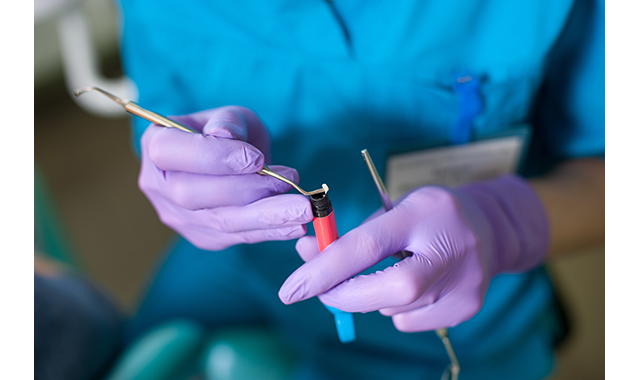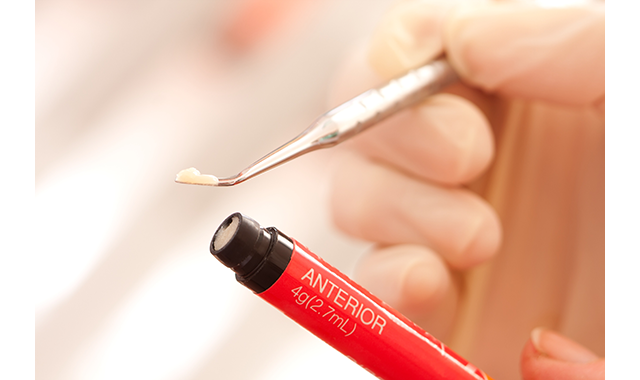What makes a material a dental composite?
We take a look at dental composites from a chemistry perspective and how those chemicals work together to create restorative material.

Dental composite is a material that’s likely used every day in the practice. But what makes a composite the material used for dental restorations?
Here, we define the chemistry of dental composites and how that chemistry affects your material’s characteristics.
Composite is a general term that means a material made of at least two other substances that, when combined, are stronger than they would be by themselves.[1] The materials involved are usually hard fillers surrounded by a different material that binds them together in a solid-state. However, the elements that are combined do not lose their individual qualities, but instead, contribute their best characteristics for a particular use.[2]
Composites are found in a variety of items, such as sidewalks, furniture, and kitchen countertops. They can help restore teeth, as well.
Dental composites use the same principles as the general term composite does. When thinking of the clinical or scientific definition of the compounds, it’s easier to think of resin composites as being comprised of three separate parts, says Nathaniel Lawson, DMD, Ph.D., division director of the Division of Biomaterials at the University of Alabama at Birmingham School of Dentistry. The essential components are dimethacrylate monomers, fillers (which are different types of glass or ceramics). The third component is composed of lesser additives, such as a coupling agent, pigments and initiators.
Each of these three parts has a job, Dr. Lawson says. The resin binds everything together and gives the composite flexibility while the filler’s job is to impart strength to the material. Meanwhile, the coupling agent’s job is to bind the filler and the resin together.
“The linker between the two is a coupling agent, usually a silane. Pigments make up the color of a composite. And photoinitiator are added to catalyze the polymerization of the resin. When blue light hits an uncured light-curing composite, the photoinitiators release free radicals, which cause the polymers to crosslink with each other,” Dr. Lawson explains.
However, the polymerization process needed to take resins from an uncured to cured state causes the polymer chains to get closer together. As they get closer together, the composite undergoes shrinkage, which can pull on the walls of a restoration, Dr. Lawson says. If a composite experiences too much shrinkage stress, it can lead to sensitivity and other complications in composite restorations for some patients.
Some composite materials are self-cured or dual-cured, Dr. Lawson says. The self-cure mechanism is one which initiates resin polymerization when two chemicals are mixed.
Dr. Rafael Bowen formulated the original dental composite in the early 1960s that was composited of silane-coated silica particles embedded into a bis-GMA (bisphenol A glycidyl methacrylate) resin. This bis-GMA resin was known as a dimethacrylate resin, as it had two methacrylate groups on either end that are capable of bonding with other methacrylate groups, which can be thought of as the “sticky ends of the composite.” A larger, stiff phenol group was present between the methacrylates which helps to prevent the materials from shrinking too much once it crosslinks.
Bis-GMA is still in use in dental composites today. There have been different dimethacrylates used in composites to impart different handling or mechanical properties to composites, Dr Lawson says. The most common are UDMA (urethane dimethacrylate) and TEGMA (triethylene glycol dimethacrylate). However, the essential parts of the composite remain relatively the same.
Continue reading on the next page...
“Nothing has changed that much as far as resins in the last 50 years, and that’s what makes all the resins similar to one another. It’s also why many materials from different companies are compatible,” Dr. Lawson explains. “You can use one company’s adhesive with another company’s composite because they are all methacrylate-based.”
The compatibility of the dental composite to other restorative materials appears to be a valuable feature to clinicians. Companies tried to introduce dental composites that were not methacrylate-based, Dr. Lawson says. As a result, the non-methacrylate composite was not compatible with anything else.
“Nobody wanted to use them,” Dr. Lawson says.
While there haven’t been many significant changes to what parts make up a dental composite, the ingredients of those parts have changed significantly over the years. One of those differences is the size of the fillers or the glass or ceramic particles inside the resin polymers.

Traditionally, the size of the particles is how composites were categorized for many years. For example, the original composites were called macrofills after a few years because the particles were much larger than the newer composites, which were called microfills.
However, Dr. Lawson cautions clinicians not to define the size of the particle they are using based on what it says on the box. The reality is there is no standardization for what size a particle needs to be to have the label “microfill” or anything else.
“You don’t have to pass a test for particle size before writing microfill on your box,” Dr. Lawson says. “We can’t rely on a marketing definition that this composite is a hybrid or a micro-hybrid.”
However, the size of the particle does matter. In dental composites, when the filler particles are smaller, they polish better. The challenge with small filler particles, however, is loading them into a composite in a high concentration without the filler particles agglomerating.
“The basic idea is,” Dr. Lawson explains, “if you have smaller filler particles, then when you polish it, the smaller filler particles that come off will leave surface irregularities that are smaller than what the eye can detect. If you have bigger filler particles and then you polish those, the larger particles pluck out, and then you have a surface roughness that is visible to the eye, and that's why they appear more rough or dull.”
The hybrid dental composites, first introduced in the 1990s and mixed both large and small fillers, addressed these disparities in an attempt to get the best of both worlds. The particle sizes are still a significant factor in the development of dental composites.
Today, most dental composites are considered nanofills or nanohybrids, meaning the particles are so small, they are measured on the nanoscale. These dental composites capitalize on the principles of nanotechnology for mechanical properties and esthetics.
“Now most filler particles, even the ‘big’ filler particles, are only 1 or 2 microns, and most filler particles have sub-micron particles. So, it's not as critical of an issue,” Dr. Lawson says.
When talking to patients about composite, however, Dr. Lawson would emphasize that composites are tooth-colored materials that will wear and last the same way amalgam fillings do. There is no reason to say that composite material is inferior in mechanical properties to any other type of restorative, he says.
However, dental composites are very technique sensitive, which is why Dr. Lawson believes amalgam fillings still have some perceived advantages over composite fillings. A perfect technique or rubber dam aren’t used to place an amalgam restoration. On the other hand, a composite needs excellent isolation and superior bonding technique to stand up to amalgam’s clinical success.
“A composite done well, can hold up any day to an amalgam, in my opinion,” Dr. Lawson says. “The difference is that an amalgam done poorly is going to do better than the composite that was done poorly.”
References
[1] “What are composites?” compositeslab.com. Web. 12 January 2020. < http://compositeslab.com/composites-101/what-are-composites/>.
[2] Ibid.
Top 10 Dental Products Report Videos of 2023
December 30th 2023Whether shot on site at a conference, recorded over Zoom, or captured in some other setting, video was a big part of the content published by Dental Products Report in 2023. The most popular videos of the year include a mix of product evaluations, roundtable discussions and weekly new product roundups. Check out the 10 most viewed videos of the year right here.